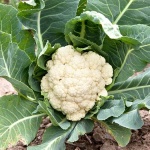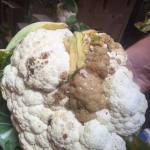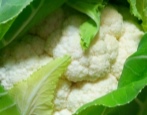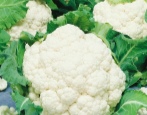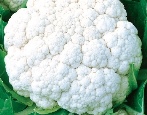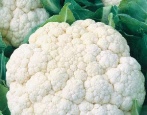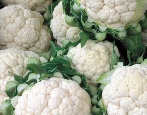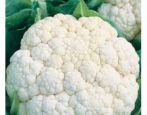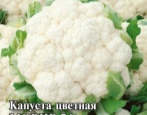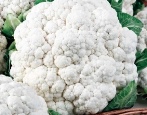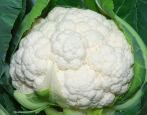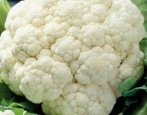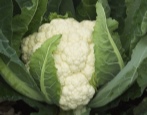
- Authors: Ludilov V.A., Korchagin V.V., Ivanova M.I., Kashleva A.I., Ilyin S.V.
- Year of approval: 2004
- Appointment: for home cooking, for freezing, for canning, for fresh consumption
- Leaf rosette: raised
- Sheet length: middle length
- Leaf color: green with a waxy bloom
- Sheet surface: slightly folded, smooth
- Yield: high
- Average yield: 2.5-3.0 kg / m2
- The form: rounded flat
Cauliflower Dachnitsa has a delicious taste and is also rich in nutrients and trace elements. Unlike many other varieties, the crop tolerates extreme weather conditions. Subject to simple agrotechnical conditions, you can get a good harvest of a useful vegetable.
Description of the variety
The summer resident has highly recommended herself as a vegetable crop. Gardeners fell in love with her for a number of significant advantages:
high resistance to temperature fluctuations, the culture tolerates both cold and heat well;
intended for cultivation both in the open field and closed;
the vegetable is rich in vitamins and minerals, especially vitamin C;
high-yielding variety;
does not shoot flower arrows;
tolerates transportation well without significant losses;
the plant has a stable immunity to most infections;
excellent taste characteristics.
There are practically no shortcomings in the variety, the exception is the composition of the soil (the summer resident does not grow well on acidic soils), the exactingness of watering and the need to regularly make additional fertilizing.
Characterization of the appearance of the plant and heads
Bushes grow undersized, with a raised rosette. The leaves are of medium length, rich green. The surface of the leaves is slightly waxy, slightly folded.
The shape of the head is round-flat, of medium size. The mass is small, the average weight can reach 0.6-1 kg. Her color is white with a cream shade, fine-grained. The heads are dense, aligned, with medium tuberosity and partial leaf cover.
Purpose and taste
Cauliflower has a bright, pronounced taste with a pleasant sweetness due to its high sugar content, which is why it has become very popular in cooking. The texture of the inflorescences is delicate.
Inflorescences are used not only in processed form, but also fresh. It is stewed, fried, boiled, steamed, canned. When frozen, the variety does not lose its beneficial properties and taste.
Ripening terms
Mid-season variety. It takes 80-100 days from germination to harvest. Cauliflower ripens evenly, although the period is rather extended. The harvested crop can be stored for quite a long time without losing its useful properties.
Yield
Very high. On average, from 1 sq. m you can collect 2.5-3 kg of vegetables.
Growing and care
The summer resident is grown in a seedling and seedless way. Although the latter option is more suitable for cultivation in the southern regions. Seeds for seedlings begin to be planted in late March - early April. They begin to plant in open ground in May, when the threat of night frosts has passed.
The soil for seedlings is chosen nutritious, consisting in equal parts of peat, turf and humus. Before you start planting seeds, you first need to sort them. Only large seeds are chosen, after which they are dipped in hot water (no more than 50 degrees) for half an hour. Then they are sealed to a shallow depth and carefully watered with warm water, then covered with foil.
Seedlings begin to germinate at a temperature of +20 degrees. With the emergence of seedlings, the temperature is slightly reduced to + 15 ... 17 degrees during the day, + 10 ... 12 degrees at night, so it gets hardened. When 2-3 full-fledged leaves appear on the seedlings, it will dive. Seedlings during this procedure are deepened to the first leaf. After 2 weeks, the plants are fed with mineral dressing, after another 3 weeks, the next dressing is applied.
The site for the culture is chosen sunny and well-ventilated. The soil is prepared in the fall. The soil is enriched with compost, and fertilizers in the form of superphosphates and potassium chloride are added. In the spring, they dig up the ground again and bring in wood ash, urea. A few days before planting seedlings in open ground, the place is covered with a black film so that the soil warms up well.
A few days before planting in a permanent place, it is not watered, but on the day of disembarkation, it is abundantly watered. They are planted in prepared holes according to the scheme 30x50 cm.The summer resident is not particularly whimsical in care. However, it requires regular watering, loosening and additional nutrition.
The soil at the roots must be constantly moist, due to the fact that the roots are located close to the surface. Irrigation is limited several weeks before the start of the harvest. 2-3 days before harvesting cabbage from the beds, watering is stopped completely.
Loosening and hilling is carried out regularly after each watering or rain. And also mulch with straw or peat. Additional nutrition is an integral part of the good development of the Summer Resident, thanks to fertilizers, ovaries are intensively formed. In this case, both organic and mineral dressings are used, which are introduced into the soil after transferring to a permanent place, during the period of budding and intensive formation of the head.
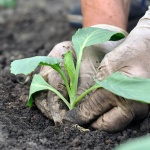
Soil requirements
The summer resident does not tolerate acidic soils, which are neutralized with lime. The soil should be light in texture and breathable.
